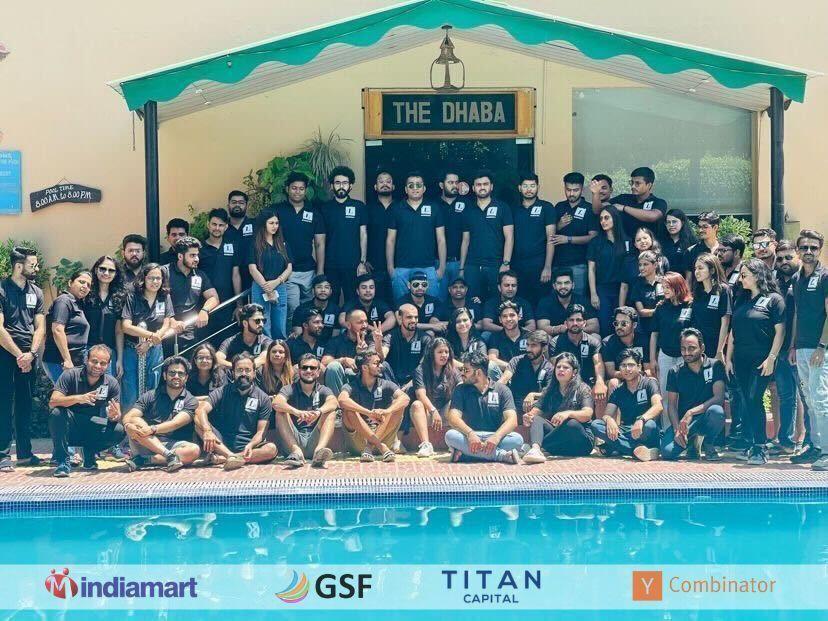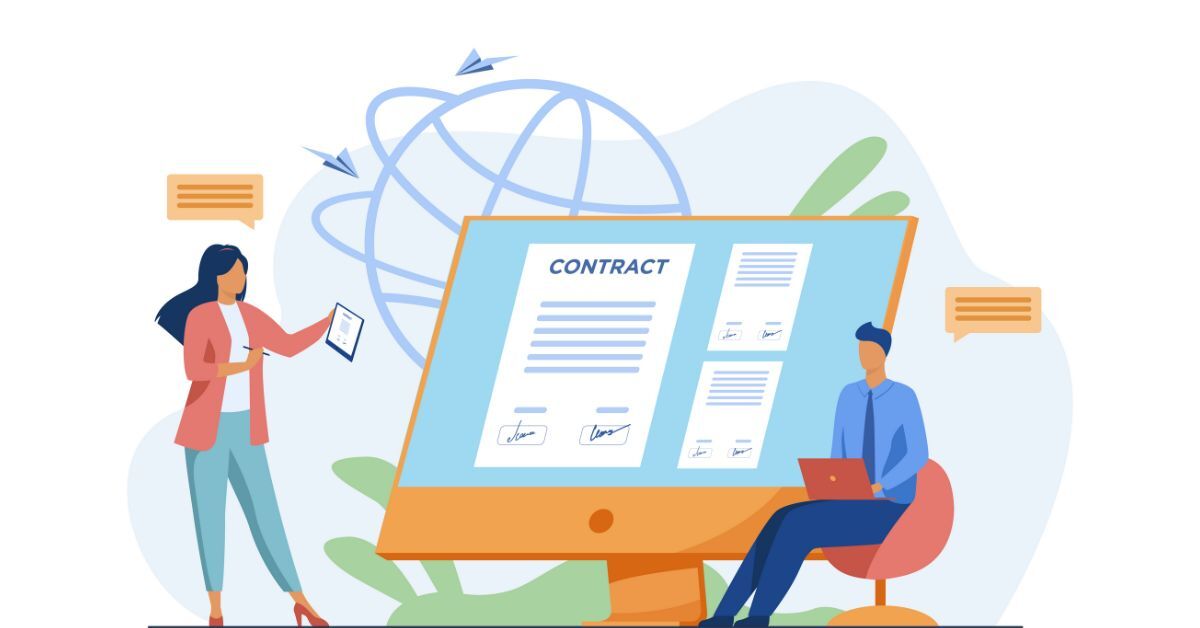Contract Generation
In 2025, technology is really changing how we handle legal documents. The use of Contract Generation tools creates contracts more easily and accurately. Agreement Generation Software helps draft contracts digitally, offering features like e-signatures and security through blockchain, plus allowing teams to work together in real time. Keeping up with the latest trends and tools in contract management can really give you an edge.
What is Content Generation?
Contract generation is the process of creating legally binding agreements efficiently and accurately using structured templates, automation, and digital tools. Modern businesses can now leverage dynamic clause libraries, Salesforce contract generation, and smart contracts powered by blockchain technology to complete agreement processes seamlessly.
To understand the contract generation process, lets take a minute to know the stages involved in writing or generating a contract:
- Sending a contract request: This is the first step in which content of the contract is decided to ensure that both the parties agree on what needs to be present in the contract.
- Research: On the basis of the context set for the contract, all the relevant information is gathered. During this process, important legislation needs to be reviewed to make the document compliant.
- Writing: Creating a contract draft with all the information gathered in the last 2 stages. Also, important clauses need to be added at this level to ensure document is legally binding.
- Final stages: At this stage, its important to check that the written document is correctly formatted. Then, the contract needs to be sent for approval. This process will stay active until the contract signing.
By the end of 2025, contract generation software will automate the population of templates with relevant data, enforce standard legal language, and facilitate collaboration across legal, sales, and procurement teams.
Why Do You Need Contract Generation Software?
- You should use contract generator software to save your time, avoid mistakes, and ensure all your contracts follow the rules.
- It promotes collaboration, streamlines approvals, and provides a clearer understanding of contract responsibilities for all parties involved.
- By utilizing technology to streamline contracting, organizations can work more efficiently.
Key Concepts in Contract Generation
The evolution of contract generation in 2025 is causing businesses to reconsider the core principles for creating, handling, and carrying out agreements. Whatever type of contract you work on, knowing these basics allows you to automate parts of the process and remain in compliance:
| Features |
Description |
| Templates as Blueprints |
Ready-made formats with customizable names, dates, and prices. |
| Smart Fill Technology |
Auto-fills fields using CRM; updates with new source data. |
| Conditional Rules |
Adds or removes clauses based on predefined if-then logic. |
| Automated Contract Generation |
Detects issues, flags terms, and suggests compliant alternative language. |
| Electronic Workflow |
Tracks edits, reviews, and signs with legal e-signature capability. |
| Automatic Organization |
Secure storage, document tagging, and reminders for important dates. |
| Continuous Updates |
Stays legally current, version-controlled, and synced across devices. |
Top Clauses and Terms for Effective Contract Drafting
Here are certain terms that are to be used in the contract generation:
Core Document Terms:
These define the foundational elements of a generation contract.
- Master Agreement: The primary contract governing an ongoing business relationship.
- Statement of Work (SOW): Outlines detailed description of deliverables and timelines.
- Amendment: A formal modification to the original contract terms.
- Exhibit/Attachment: Supplementary documents that support or elaborate on contract content.
Structural Components:
These define the framework shaping contract enforceability in an automated contract generation workflow.
- Recitals/Preamble: Offer background information and context for the agreement.
- Definitions Section: Clarifies precise meanings of capitalized terms.
- Representations & Warranties: Factual assertions by parties regarding facts or conditions.
- Covenants: Ongoing obligations during the contract term agreed upon by the parties.
- Conditions Precedent: Requirements that must be met before the contract becomes enforceable.
Operational Terms:
It manages the practical implementation requirements of a contract generation tool.
- Term/Termination: Defines contract length and how and when it may end.
- Service Levels/KPIs: Specifies expected performance targets to ensure consistent service delivery.
- Delivery Milestones: Establishes timeline checkpoints to track progress and ensure accountability.
- Acceptance Criteria: Outlines conditions that must be met to approve deliverables.
- Change Order Process: Provides structured methods to manage and approve contract modifications.
Risk Management Terms:
These allocate liability and protection mechanisms in any generator contract.
- Limitation of Liability: Limits the total amount one party pays if something fails.
- Indemnification: One party compensates another for specific damages or legal losses.
- Force Majeure: Excuses obligations during unforeseeable, external, and uncontrollable disruptive events.
- Insurance Requirements: Requires parties to maintain specific insurance coverage throughout the contract.
- Liquidated Damages: Pre-agreed financial compensation for specific contract breaches or performance failures.
Intellectual Property Terms:
These regulate knowledge asset ownership within contract generation workflows.
- License Grant: Defines allowed usage scope under specific rights granted by the licensor.
- Ownership Allocation: Specifies who retains rights to intellectual property or developed materials.
- Proprietary Rights: Protects sensitive information and enforces rights over proprietary business content.
Specialized Clauses:
These address specific business protections using contract generation software.
- Non-Compete: Restrictions on competitive activities
- Non-Solicitation: Limits on approaching employees/customers
- Survival Provisions: Terms enduring post-termination
- Dispute Resolution: It controls conflict management procedures.
Execution Terms:
These ensure valid agreement formation in any automated contract generation system.
- Electronic Signatures: Validates contracts executed digitally under applicable electronic signature laws.
- Authority Representations: Confirms each signer has the legal power to bind their party.
- Effective Date: Specifies the exact date contract obligations begin and become enforceable.
- Notice Provisions: Outlines acceptable formats and addresses for sending official communications.
Technologies in Contract Generation
While understanding contract terms is important, it’s the technology behind contract generation that’s truly transforming legal workflows in 2025. Let’s examine the cutting-edge technologies powering modern contract generation:
| Technology |
Description |
| Contract Lifecycle Management (CLM) Software |
Tools to manage the end-to-end contract process. |
| Document Automation Tools |
Automated contract generation using templates and predefined logic. |
| Artificial Intelligence (AI) |
Analyzes contract language, suggests clauses, and detects risks using AI-powered Automated Contract Generation. |
| Natural Language Processing (NLP) |
Enables machines to understand and interpret legal language in contracts. |
| E-signature Tools |
Enables the electronic signing of contracts in most contract generation tools. |
| Blockchain |
Provides secure, immutable records of contract execution. |
| Smart Contracts |
Self-executing contracts with terms directly written into code. |
| Cloud Storage |
Centralized access and storage of contract documents. |
| Version Control Systems |
Tracks changes and maintains different versions in the contract generation process. |
| Collaboration Platforms |
Allows real-time editing and stakeholder collaboration. |
| Data Analytics Tools |
Analyzes contract data for insights, compliance, and performance. |
| OCR (Optical Character Recognition) |
Converts scanned or image-based contracts into editable digital text within contract generator software. |
| APIs (Application Programming Interfaces) |
Integrate contract tools with CRMs, ERPs, and legal databases. |
What Does the Contract Generation Process Typically Look Like?
With human knowledge and digital power, today’s contract generation process enables the formation of better and more flexible contracts. Here’s how the current process transfers agreements from discussion to practical outcomes:
1. Initiation
- The user selects the type of contract (e.g., NDA, sales agreement) via a contract generation tool.
- Answers a few basic questions (names, dates, amounts).
2. Template Selection or Drafting
- A pre-approved template is selected based on contract type.
- The system may auto-fill existing company/customer data.
3. AI-Powered Drafting
- Instantly builds a document using approved templates with accurate details.
- Standard legal protections and necessary clauses are added automatically via contract generation software.
4. Quick Review
- The legal team checks key points (takes minutes, not hours).
- Makes any needed adjustments with intuitive editing tools.
5. Easy Negotiation
- All parties review and propose changes in a shared, cloud-based document.
- AI suggests wording that will help speed up the resolution, a hallmark of automated contract generation.
- Everyone works on the most recent version with the help of real-time upgrades.
6. E-Signature & Execution
- Once finalised, the contract is signed electronically with a single click.
- No printing/scanning needed.
- The signed version is saved and securely stored.
Stages of Creating Contracts- The 8 Steps Framework (2025)
While the benefits of generating contracts are clear, their real value emerges through how organizations implement these solutions. Here’s the proven 8-stage framework adopted by legal and business leaders in 2025:
Requirement Gathering
The first step in the contract generation process is to determine why the contract is necessary and explain its primary purpose. The main parties and key terms in the contract are stated. Here, the Generation Contract process begins by outlining the fundamental expectations.
Template Selection
The contract generation software platform has a contract library from which a pre-approved template is chosen. This uses standardized wording and phrases to assure consistency, legal compliance, and a quicker response.
Clause Customization
Add, change, or remove parts of the clauses to suit the particular transaction and the law. Customization helps companies control risks and follow the rules. The contract is adjusted to meet the company’s distinctive needs.
Data Population
All the necessary contract details, such as names, dates, payment info, and what is being delivered, are included. Drawing this data from integrated systems is commonly done by automation tools. Entering correct information reduces errors and speeds up the automated contract generation process.
Examine and Communicate with Others.
All pertinent parties—legal, procurement, sales, and clients—are given access to the draft contract for evaluation and comments. Version control, edit tracking, and transparent negotiation methods are all made possible by real-time collaboration technologies.
Approval Workflow
Each contract goes through a set of step-by-step approvals, handled by legal, finance, and management departments. Automated workflows within agreement generation software ensure that internal policies are followed and the right people sign off at the right time.
Execution
Once approved, all involved parties sign the contract. Many organizations turn to electronic signatures because they ensure quick turnaround, eliminate paper-based delays, and maintain audit trails.
Managing and Storing
All executed contracts are securely stored in centralized repositories provided by the contract generator software. Important dates, such as renewals and compliance, are logged by the system. At this point, contract execution is sustained, and possible risks are handled.
Features of Contract Generation Software in 2025
As generator contract technology advances, modern software is becoming smarter, faster, and more secure than ever. Below are the key features that define agreement generation software in 2025, designed to simplify and automate every step of the contract lifecycle:
| Feature |
Key Capabilities |
| AI-Powered Smart Drafting |
- Instant first drafts in plain English, Spanish, Mandarin, or any other language by automated contract generation.
- Auto-suggests clauses based on deal type and risk level.
- Real-time compliance checks against global regulations.
|
| One-Click Customization |
- Voice commands for editing (e.g., “make payment due in 45 days”) within the contract generator software.
- Drag-and-drop clause builder with plain language summary.
- Automatic redlining when terms deviate from standards.
|
| Frictionless Signing |
- Biometric e-signatures (face/fingerprint scan).
- Blockchain-verified digital notarization.
- Automatic filing in company repositories.
|
| Self-Managing Contracts |
- Auto-triggered renewals/terminations.
- Smart alerts for deadlines and obligations.
- Performance tracking against KPIs.
|
| Always-On Security |
- Military-grade encryption via the contract generation software.
- Automatic backup to secure cloud.
- Watermarking to prevent leaks.
|
| Seamless Connections |
- Instant sync with all major business apps.
- API integration with payment systems.
|
Which is the Best Contract Generation Software List in 2025?
Choosing the right agreement generation software can streamline your legal workflows, reduce errors, and save valuable time. Here’s a curated list of the best contract generation tools that offer powerful features:
,
| Feature |
Legistify |
Ironclad |
Conga Contracts |
PandaDoc |
HelloSign |
| AI Clause Suggestions |
✅ Yes |
✅ Yes |
✅ Yes |
❌ No |
❌ No |
| End-to-End CLM |
✅ Yes |
✅ Yes |
✅ Yes |
❌ No |
❌ No |
| Legal Compliance Controls |
✅ Advanced |
✅ Basic |
❌ No |
❌ No |
❌ No |
| Custom Approval Workflows |
✅ Flexible |
✅ Yes |
✅ Yes |
❌ No |
❌ No |
| Dynamic Templates |
✅ Yes |
✅ Yes |
✅ Yes |
✅ Yes |
✅ Yes |
| Clause Library & Standardisation |
✅ Built-in |
✅ Yes |
❌ No |
❌ No |
❌ No |
| Blockchain / Smart Contract Ready |
✅ Supported |
❌ No |
❌ No |
❌ No |
❌ No |
| CRM Integration (e.g., Salesforce) |
✅ Customizable |
✅ Deep |
✅ Native |
✅ Basic |
✅ Basic |
| eSignature Integration |
✅ Native |
✅ Yes |
✅ Yes |
✅ Yes |
✅ Yes |
| Industry Focus |
All Business Functions |
Large Enterprises |
CRM Users |
Sales, SMBs |
General Use |
Unlike other tools that focus on specific areas, such as salesforce contract generation or simple sales contracts, Legistify provides users with an extensive and comprehensive AI-based contract lifecycle management (CLM) system that is even used and trusted by various teams, such as legal, procurement, and enterprise.
The platform supports automated contract generation through intelligent drafting, a compliance-first approach, Android-only features, and ready-to-use integrations, making the software a primary solution for companies that prefer to deal with speed, security, and standardization — all in a single platform.
What are the benefits of automating contract creation?
Here are some of the key benefits of using contract generation software that can transform how your organization handles agreements:
| Benefits |
Description |
| Efficiency |
Contract generation software automates drafting processes, saving time and effort by eliminating repetitive tasks. |
| Accuracy |
By using standardized templates and predefined clauses, contract generation software reduces the risk of errors. |
| Compliance |
Contract software includes built-in checks that help organizations comply with legal, regulatory, and internal policies. |
| Risk Reduction |
Automated contract systems identify potentially risky clauses and non-standard terms early in the process. |
| Cost Savings |
By minimizing legal review time, automating administrative tasks, and reducing manual errors, contract generation software significantly cuts costs. |
| Collaboration |
Modern contract tools offer collaborative features that enable real-time input, comments, and approvals from multiple users. |
Best Practices in Contract Generation
Effective contract generation ensures accuracy, speed, and legal compliance. Adopting best practices streamlines the process and minimizes risks. Here is what to go ahead with:
| Best Practices |
What to Do |
Why It Matters |
| Use Contract Software |
Start with approved templates in a digital contract platform. |
Speeds up creation and keeps terms compliant. |
| Auto-Populate Details |
Link business tools to auto-fill names, amounts, and dates. |
Cuts down errors and saves manual effort. |
| Build Conditional Logic |
Add smart rules to modify terms based on contract type. |
Ensures accurate and dynamic clauses. |
| Review with AI Help |
Let AI flag gaps or risky wording. |
Enhances quality and reduces legal risk. |
| Enable Quick Signing |
Use one-click e-signatures and status tracking. |
Speeds up approval and execution time. |
| Centralize Storage |
Keep contracts in a secure, searchable digital location. |
Prevents loss and helps manage renewals. |
Future Trends in Contract Generation (2025 and Beyond)
As technology advances, contract automation is set to undergo transformative changes that will redefine how businesses create, execute, and manage agreements. Below are some key trends shaping the future of contract generation in 2025 and beyond:
| Trend |
Impact |
| AI-Powered Autonomous Contracts |
Self-drafting agreements that reduce manual work by 80% while maintaining legal precision. |
| Blockchain Smart Contracts 2.0 |
Tamper-proof, self-executing contracts with dynamic terms (e.g., auto-adjusting interest rates) powered by next-gen agreement generation software. |
| Predictive Contract Analytics |
AI forecasts negotiation outcomes and suggests optimal terms before drafting begins, enabling more informed and resilient contracts. |
| Real-Time Regulatory Updates |
Contracts auto-adapt to new laws (e.g., tax codes, data privacy regulations) through advanced contract generator software, ensuring continuous compliance. |
| Metaverse Contract Signing |
Virtual reality notarization and NFT-based authentication for remote deals integrated with salesforce contract generation systems, enhancing security and user experience in digital environments. |
Legistify’s Contract Creation Software: Automate The Process
Among the most popular programs, Legistify is indeed the perfect software for modern ways to generate contract. Legistify helps the legal, procurement, and business teams draft, negotiate, and manage contracts with ease thanks to its AI-powered drafting engine, e-signature integration, and built-in compliance checks.
| Steps |
What You Do |
| Pick a Template |
- Choose from 100+ ready-made contracts (NDAs, sales, freelancer agreements) using the powerful contract generation tool, such as Legistify.
- Answer simple questions to customize.
|
| AI Does the Work |
- Helps in generating automated contracts.
- Checks for errors and missing terms.
- Suggests the best agreement generation software solution.
|
| Sign & Manage |
- Get e-signatures in one click.
- Stores contracts securely.
- Send renewal reminders.
|
Whether you’re a startup or a big company, your contracts with Legistify are always smart, secure, and one step ahead. Streamline your contract lifecycle with Legistify – where legal meets automation.




